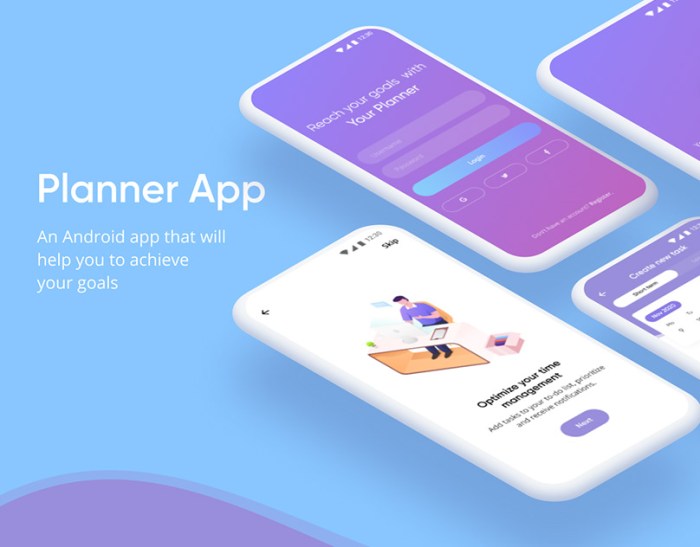Google Planner App is more than just a scheduling tool; it’s a dynamic platform for organizing your entire life, from personal tasks to complex projects. This comprehensive guide delves into its features, user experience, and practical applications, providing a clear understanding of how to maximize its potential for productivity and efficiency.
Whether you’re a student juggling multiple assignments, a professional managing a demanding workload, or someone seeking a streamlined personal organizer, the Google Planner App can significantly improve your productivity. We’ll explore its functionalities and capabilities, comparing it to popular alternatives to highlight its unique strengths.
Introduction to Google Planner App
Google Planner is a versatile scheduling and task management tool designed to help users organize their personal and professional lives. It integrates seamlessly with other Google Workspace applications, offering a centralized platform for planning and coordinating tasks. This article provides a comprehensive overview of Google Planner’s functionalities, key features, and target audience.
Overview of Functionalities
Google Planner facilitates the creation and management of plans, which can encompass various types of tasks and projects. It allows users to break down large projects into smaller, manageable tasks, set deadlines, and assign priorities. The app also provides features for collaborating with others, sharing plans, and managing shared calendars.
Key Features and Distinctions
- Task Management: Google Planner excels at breaking down complex projects into smaller, actionable tasks, facilitating better time management.
- Deadline Setting: The app allows for clear deadlines and reminders for each task, reducing the risk of missed deadlines.
- Collaboration: Sharing plans and calendars with collaborators is straightforward, enabling effective teamwork and communication.
- Integration: Seamless integration with other Google Workspace applications, like Gmail and Calendar, provides a cohesive workflow.
- Flexibility: Users can create plans for various purposes, from personal schedules to large-scale projects.
Target Audience and Core Purpose
Google Planner caters to a broad audience, from students and freelancers to project managers and teams. Its core purpose is to provide a user-friendly platform for organizing tasks, setting deadlines, and collaborating on projects. The tool aims to improve time management and productivity.
Use Cases Across Contexts
Google Planner can be effectively used in various contexts, including personal scheduling, professional project management, and team collaborations. For instance, students can use it to plan study sessions, freelancers to manage client projects, and teams to coordinate workflows.
Comparison to Other Scheduling Apps
| Feature | Google Planner | Outlook Calendar | Todoist |
|---|---|---|---|
| Task Management | Excellent for breaking down complex projects | Good for scheduling appointments | Strong focus on individual tasks |
| Collaboration | Solid, integrated with other Google services | Good for scheduling meetings | Limited collaborative features |
| Visual Design | Clean and minimalist | Traditional calendar view | Task-centric view |
| Integration | Seamless with Google Workspace | Limited integration options | Limited third-party integrations |
Features and Capabilities
Google Planner’s core strength lies in its ability to structure tasks and projects, enabling users to visualize and manage their work effectively. This section delves into the app’s planning and scheduling capabilities.
Planning Features
The app offers various planning features, including creating plans, adding tasks, setting deadlines, and prioritizing tasks. Users can organize their tasks into specific days, weeks, or months, depending on the complexity of the project.
Scheduling Capabilities
- Task Management: Detailed task management features enable users to break down projects into manageable components.
- Deadlines and Reminders: Setting deadlines and reminders ensures tasks are completed on time.
- Priority Levels: Assigning priorities helps users focus on the most crucial tasks.
Task and Project Organization
Google Planner allows for various ways to organize tasks and projects, including creating sub-plans and nesting tasks within plans. This hierarchical structure aids in managing intricate projects effectively.
Collaboration and Sharing
Sharing plans and collaborating with others is straightforward, enabling seamless teamwork. The app provides different levels of access and permissions, promoting collaboration without compromising individual workspaces.
Integrations with Google Workspace

Google Planner seamlessly integrates with other Google Workspace applications, such as Calendar and Gmail, facilitating a unified workflow.
Strengths and Weaknesses of Features
| Feature | Strengths | Weaknesses |
|---|---|---|
| Task Management | Flexible task breakdown, clear deadlines | Might not be ideal for highly complex tasks without sub-plans |
| Collaboration | Easy sharing, access controls | Collaboration features could be more robust for large teams |
| Integration | Unified workflow with other Google services | Limited integration options outside Google Workspace |




